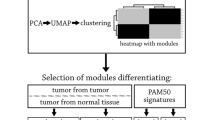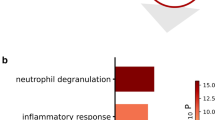Abstract
Fluorosis due to longtime exposure of fluoride with deleterious public health problem is common in developed and developing countries. Researches demonstrated that fluoride induces the gene expression and causes apoptosis. The present study aims to predict potential transcription factor (TF) and associated protein kinase which are responsible for the regulation of gene expression exposure of fluoride. In this study, 60 genes classified into 16 gene families were shorted that show the differential expression (up/down) in human exposure to fluoride; where 47 genes show the decreased expression and other 13 show the increased expression. The TFs SOX2, GATA1 and MYC for down-regulation gene and MYC, GATA1 for up-regulation of genes expression were predicted using the X2K approach. The potential protein kinase MAPK1, MAPK3, CSNK2A1 and CSNK2A2 for down-regulation and MAPK1, MAPK3, MAPK8, IKBKB AKT1, GSK3B and CDK2 for up-regulation of the genes are identified which are connected to a maximum number of intermediate protein and TFs that can be applied to the prediction novel targeting the disease-suppressive potential target in human longtime fluoride exposure.




Similar content being viewed by others
References
Bergandi L, Aina V, Garetto S, Malavasi G, Aldieri E, Laurenti E, Ghigo D (2010) Fluoride-containing bioactive glasses inhibit pentose phosphate oxidative pathway and glucose 6-phosphate dehydrogenase activity in human osteoblasts. Chem Biol Interact 183(3):405–415
Chen EY, Xu H, Gordonov S, Lim MP, Perkins MH, Ma’ayan A, (2012) Expression2Kinases: mRNA profiling linked to multiple upstream regulatory layers. Bioinformatics 28(1):105–111
Deak M, Clifton AD, Lucocq JM, Alessi DR (1998) Mitogen-and stress-activated protein kinase-1 (MSK1) is directly activated by MAPK and SAPK2/p38, and may mediate activation of CREB. EMBO J 17(15):4426–4441
Gandhi D, Naoghare PK, Bafana A, Kannan K, Sivanesan S (2017) Fluoride-induced oxidative and inflammatory stress in osteosarcoma cells: does it affect bone development pathway? Biol Trace Elem Res 175(1):103–111
Harinarayan CV, Kochupillai N, Madhu SV, Gupta N, Meunier PJ (2006) Fluorotoxic metabolic bone disease: an osteo-renal syndrome caused by excess fluoride ingestion in the tropics. Bone 39(4):907–914
Karube H, Nishitai G, Inageda K, Kurosu H, Matsuoka M (2009) NaF activates MAPKs and induces apoptosis in odontoblast-like cells. J Dent Res 88(5):461–465
Lachmann A, Ma’ayan A (2009) KEA: kinase enrichment analysis. Bioinformatics 25(5):684–686
Meisner H, Heller-Harrison R, Buxton J, Czech MP (1989) Molecular cloning of the human casein kinase II alpha subunit. Biochemistry 28(9):4072–4076
Mittal M, Flora SJS (2006) Effects of individual and combined exposure to sodium arsenite and sodium fluoride on tissue oxidative stress, arsenic and fluoride levels in male mice. Chem Biol Interact 162(2):128–139
National Research Council (2007) Fluoride in drinking water: a scientific review of EPA's standards, National Academies Press
Salgado-Bustamante M, Ortiz-Pérez MD, Calderón-Aranda E, Estrada-Capetillo L, Niño-Moreno P, González-Amaro R, Portales-Pérez D (2010) Pattern of expression of apoptosis and inflammatory genes in humans exposed to arsenic and/or fluoride. Sci Total Environ 408(4): 760–767. http://www.nap.edu/catalog/11571.html. Accessed 9 April 2008
WHO (World Health Organization) (2001) Environmental health criteria 224. In: Gomez-Caminero A, Howe P, Hughes M, Kenyon E, Lewis DR, Moore M, Ng J, Aitio A, Becking G (eds) Arsenic and arsenic compounds. Monograph of the Inter-Organization Programme for the Sound Management of Chemicals, Chapter 1, 2nd edn. World Health Organization, Geneva, pp 4–5
WHO (World Health Organization) (2006) Fluoride in drinking-water. In: Fawell J, Bailey K, Chilton J, Dahi E, Fewtrell L, Magara Y (eds) WHO drinking water quality series. Padstow, TJ International (Ltd), pp 22–24
Xiong X, Liu J, He W, Xia T, He P, Chen X, Wang A (2007) Dose–effect relationship between drinking water fluoride levels and damage to liver and kidney functions in children. Environ Res 103(1):112–116
Zhang Y, Li W, Chi HS, Chen J, DenBesten PK (2007) JNK/c-Jun signaling pathway mediates the fluoride-induced down-regulation of MMP-20 in vitro. Matrix Biol 26(8):633–641
Zhang M, Wang A, Xia T, He P (2008) Effects of fluoride on DNA damage, S-phase cell-cycle arrest and the expression of NF-κB in primary cultured rat hippocampal neurons. Toxicol Lett 179(1):1–5
Zhang S, Zhang X, Liu H, Qu W, Guan Z, Zeng Q, Xia T (2015) Modifying effect of COMT gene polymorphism and a predictive role for proteomics analysis in children’s intelligence in endemic fluorosis area in Tianjin, China. Toxicol Sci 144(2):238–245
Author information
Authors and Affiliations
Corresponding author
Rights and permissions
About this article
Cite this article
Choudhari, J.K., Sahariah, B.P., Choubey, J.K. et al. Identification of potential transcription factor and protein kinases for regulation of differentially expressed genes for fluoride exposure in human using Expression2Kinases (X2K) approach. Netw Model Anal Health Inform Bioinforma 6, 7 (2017). https://doi.org/10.1007/s13721-017-0148-7
Received:
Revised:
Accepted:
Published:
DOI: https://doi.org/10.1007/s13721-017-0148-7




